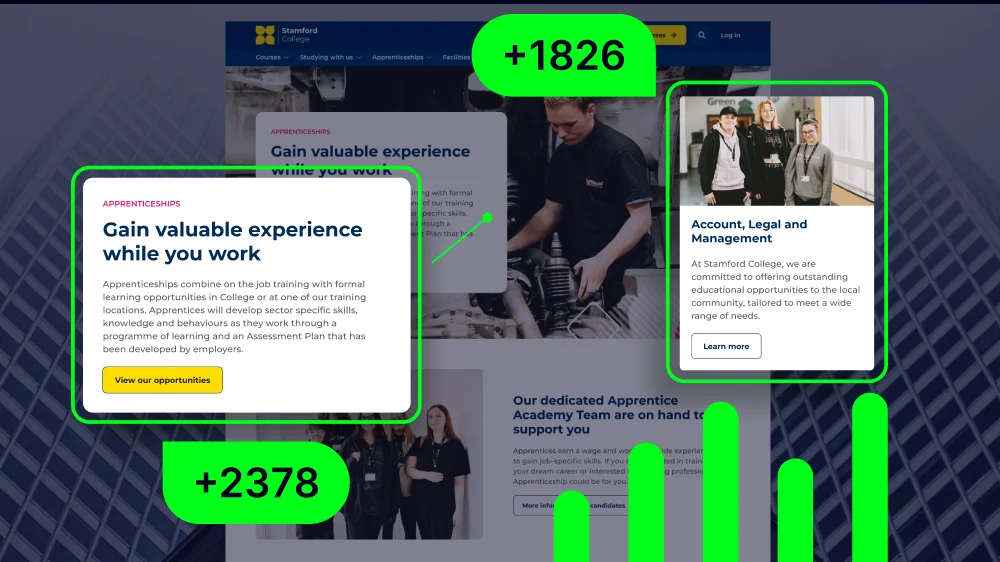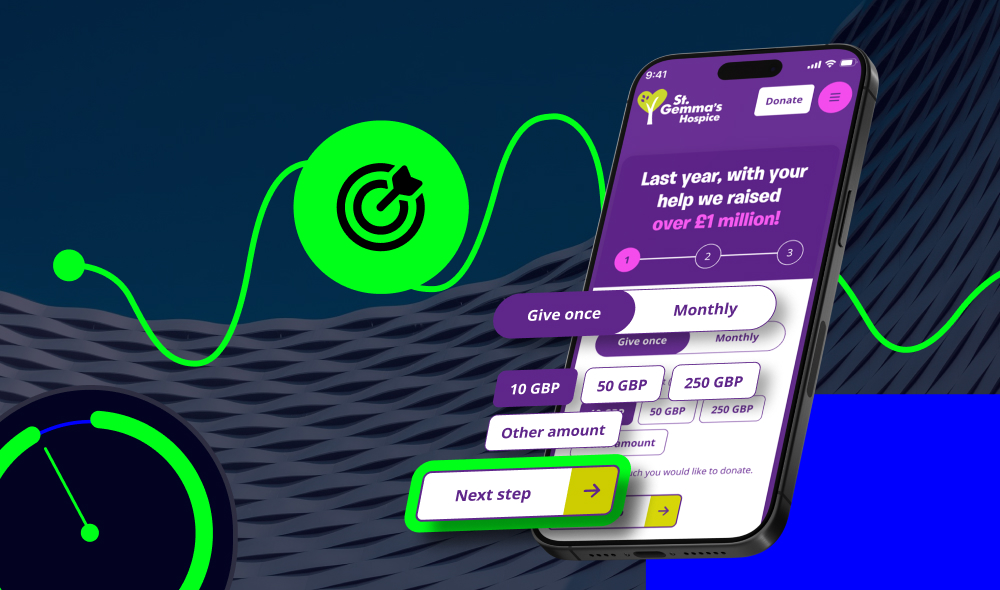Sustainability in Web Design: How to Create a More Sustainable Website (And Why You Should)
When you’re online, every click, scroll and page load consumes energy. And when millions of websites are bloated with oversized files, inefficient code and unnecessary bells and whistles, that energy use adds up fast.
The result? A digital world with a carbon footprint as large as the airline industry.
The good news is that we can design smarter. This is where sustainable website design comes in.
Sustainable web design isn’t just good for the planet — it’s good for users, businesses and budgets.
Below we’ll explore some practical ways to shrink your website’s impact while boosting performance, usability and longevity.

Harry Hammett is a detail-driven Project Co-Ordinator at Itineris, ensuring seamless delivery across digital projects. With a keen eye for organisation and efficiency, he keeps teams aligned and clients informed, driving success through clear communication and meticulous planning.
Table of Contents
What is Sustainable Website Design?
Sustainable website design is all about creating digital experiences that use fewer resources and have a lower environmental impact. That includes how a website is designed, built, hosted and maintained.
The goal is to make websites faster, cleaner and more energy-efficient — without sacrificing performance or user experience.
A sustainable website loads quickly, uses less data and runs efficiently across all devices. It avoids unnecessary features, large files and overly complex code.
It’s built to last and easy to maintain, reducing the need for frequent redesigns. And it takes into account the full lifecycle of a digital product, from the carbon footprint of the server to the energy used by a user’s device.
This isn’t just about being green. It’s about smart, forward-thinking design that benefits users, developers, businesses and the planet.
Why Sustainability Matters in Website Design
The internet may feel invisible, but it runs on physical infrastructure that consumes huge amounts of electricity.
In fact, the internet is responsible for around 4% of global carbon emissions, which is roughly the same as the entire aviation industry. And, that number is only increasing.
Data centres, servers and networks all use a lot of power. And the more data your website sends, the more energy it takes to deliver it.
Every time someone visits your site, their device pulls in data from a server. So, if your website is bloated with large images, autoplay videos or inefficient code, that visit uses more energy.
Multiply that by thousands or millions of users, and the environmental impact grows quickly.
Sustainable web design helps cut down on that impact. It reduces how much energy your site uses, shrinking your organisation’s digital carbon footprint. Plus, it makes your site faster and more accessible.
Taking a sustainable approach to web design also future-proofs your website.
As regulations tighten and user expectations shift, sustainability becomes a more important expectation. It’s something that can add to your corporate values or environmental responsibility goals.
There’s also a business case. A more sustainable website is faster to load, easier to navigate and more inclusive for users on older devices or slower connections. This means it can boost SEO, improve the user experience and lower bounce rates.
So, as regulations tighten and public expectations rise, designing sustainably is a smart investment in future-proofing your digital presence.
That means happier users, better search rankings and lower bounce rates. It’s a win all round.
Sustainable Web Design Practices
Designing a sustainable website means thinking about efficiency at every stage — from how your site is designed to how it’s hosted.
Here are some key practices that can help reduce the environmental impact of your website.
| Best Practice | Description |
|---|---|
| Optimise Page Weight | Compress images, use efficient formats like WebP, minimise fonts and clean up unused code to reduce load time and carbon impact. |
| Choose Efficient Design and UX | Use simple layouts, fewer colours, and remove non-essential elements. Focus on reducing clicks and improving usability. |
| Reduce Third-Party Scripts | Audit and remove unnecessary external scripts. Use lightweight, privacy-first tools to reduce background load and requests. |
| Use Green Hosting Providers | Choose hosting that runs on renewable energy or offsets emissions. Consider servers closer to your audience for efficiency. |
| Cache and Minify Everything | Use caching and minification to reduce server load and download size. Set long expiry dates for static files. |
| Use a Lightweight CMS or Framework | Avoid bloated plugins and themes. Consider static site generators or clean WordPress setups for lean performance. |
| Prioritise Mobile and Low-Bandwidth Experiences | Optimise for smaller screens, serve lower-res assets and test on slow connections to ensure universal access. |
| Clean Up Regularly | Audit and remove old pages, files and plugins. Keep content relevant to avoid waste and boost performance. |
| Create Clear, Purposeful Content | Write concise content with clear structure. Avoid autoplay media and guide users quickly to what they need. |
| Embrace Minimalism in Design | Reduce design clutter and focus on essentials. Less content and code means faster load times and lower emissions. |
| Implement Dark Mode Options | Dark mode saves energy on OLED screens and improves UX. Offer it as an opt-in feature where appropriate. |
| Regularly Audit and Update Content | Remove unused or outdated information. Fresh, relevant content reduces server strain and improves user experience. |
| Educate and Involve Your Team | Build awareness across your team. Shared responsibility leads to smarter, greener design decisions at every level. |
Optimise Page Weight
Every time a user loads a page, data is transferred from the server to their device. The larger the page, the more energy it takes to load.
To reduce this, you’ll want to keep your page weight as low as possible.
Compress images without compromising quality. Convert them to efficient formats like WebP or AVIF. Use CSS or SVGs for simple graphics instead of full image files.
Minimise your use of custom fonts — each font file adds to the page size.
Where possible, stick to system fonts. Clean up your code and remove any unused CSS or JavaScript.
Although these changes might seem tiny, they add up and make a major difference over the long run. Every kilobyte saved reduces the carbon impact and improves loading times.
Choose Efficient Design and UX
Sustainable design is simple, clear and focused.
Cluttered interfaces, unnecessary animations and bloated visual elements slow users down and require more energy to load.
Streamline your layouts. Use fewer colours, reduce reliance on high-resolution imagery and remove decorative flourishes that don’t serve a purpose.
Think about user journeys. Can you help users find what they need in fewer clicks?
A more intuitive structure means people spend less time browsing and loading pages. That’s not just better for sustainability — it also leads to higher conversions and better engagement.
Reduce Third-Party Scripts
Third-party scripts, like tracking pixels, social sharing widgets or chatbots, can quietly add significant weight to your site.
They often load external resources, slow down performance and run in the background even when users don’t interact with them.
Audit your site and remove any third-party tools that aren’t essential.
Replace multiple trackers with a privacy-first analytics tool which uses far less data and respects user privacy. The fewer requests your site has to make, the more efficient it becomes.
Use Green Hosting Providers
Web hosting has a hidden carbon footprint. Servers consume huge amounts of electricity and are often powered by fossil fuels.
Choosing a green host is one of the most effective ways to lower your site’s environmental impact.
Look for providers that use renewable energy, such as wind or solar, or those that offset their emissions with certified climate programs.
Some providers focus specifically on eco-friendly hosting. Hosting your site in a data centre that’s geographically closer to your users can also reduce the energy used in content delivery.
Cache and Minify Everything
Efficient caching can dramatically reduce the energy used to serve your content.
By storing static copies of your pages and files, you can avoid having to rebuild them from scratch every time a user visits. This reduces server load and speeds up delivery.
Minify your HTML, CSS and JavaScript to remove extra characters, white space and comments.
This makes files smaller and faster to download. Set long expiry dates on static files so browsers can reuse them instead of re-downloading on repeat visits.
Discover best practices on how to speed up your WordPress site →Use a Lightweight CMS or Framework
If you’re building a custom site, choose a framework that’s lean and efficient.
If you’re using a CMS like WordPress, keep it clean and minimal. Don’t overload it with plugins. Stick to well-coded themes and avoid page builders that generate unnecessary code.
Consider headless setups or static site generators. These tools create pre-rendered pages that load incredibly fast and use fewer resources than traditional CMS platforms.
They’re especially useful for content that doesn’t change often.
Prioritise Mobile and Low-Bandwidth Experiences
Many users, especially in rural or underserved areas, rely on slower connections and older devices.
A sustainable website should be accessible and fast for everyone, no matter what device or network they’re on.
Use responsive design to serve optimised layouts and assets for smaller screens.
Load smaller image sizes on mobile. Limit background scripts that drain battery or hog bandwidth. Test your site on 3G networks to make sure it still performs well.
Clean Up Regularly
Sustainability isn’t just about your site’s launch, it’s about ongoing care.
Set a regular schedule to audit your website. Remove outdated pages, media files and unused plugins or code. The more clutter you remove, the lighter and faster your site becomes.
Check your analytics. If pages or resources aren’t being used, don’t keep them live.
Make sure any content you do keep is still relevant and valuable. Less waste means less energy used, and a better experience for users.
Create Clear, Purposeful Content
The content on your website should be focused and easy to understand.
Rambling, unstructured content keeps people scrolling longer than necessary and leads to more page reloads. That’s wasted energy.
Write clearly. Structure your content so users can scan and find what they need quickly. Use simple language and descriptive headings.
If you’re embedding media like videos, only do so when it genuinely enhances the message. Always give users the choice to load media rather than setting it to autoplay.
Embrace Minimalism in Design
Adopting a minimalist design approach not only enhances user experience but also contributes to sustainability.
By focusing on essential elements and reducing unnecessary components, you can create a cleaner, more efficient website. This approach aligns with the principle of “less is more,” promoting faster load times and reduced energy consumption.
Explore the key principles of user-centred website design →Implement Dark Mode Options
Offering a dark mode option can lead to energy savings, especially on OLED and AMOLED screens where black pixels consume less power.
This feature not only caters to user preferences but also contributes to the overall sustainability of your website.
Regularly Audit and Update Content
Conducting periodic audits of your website content ensures that outdated or irrelevant information is removed.
This practice reduces server load and data transfer, leading to lower energy usage. Beyond sustainability, maintaining up-to-date content enhances user trust and engagement.
Educate and Involve Your Team
Promoting awareness and understanding of sustainable web design principles among your team members fosters a culture of responsibility.
Encourage collaboration and continuous learning to implement best practices effectively. This collective effort can lead to innovative solutions that further reduce your website’s environmental impact.

Embrace Sustainable Website Design
Of course, most organisations won’t make sustainability the absolute focus of their website strategy. However, there are two big reasons why it’s important to consider.
First, there’s the sustainability factor. Organisations across industries are looking for ways to improve their environmental impact, and sustainable web design is a great way to add to this.
Second, sustainable website design comes with many added user experience benefits. A sustainable site is an efficient, accessible, easy to use website. If you follow the practices above, your site will be faster, easier to navigate and more enjoyable to use.
This can make a big difference to your website’s SEO, engagement levels and overall digital success.
So, what are you waiting for? Embracing sustainability in website design just makes sense.
Need help getting it right? Just get in touch with our team.




